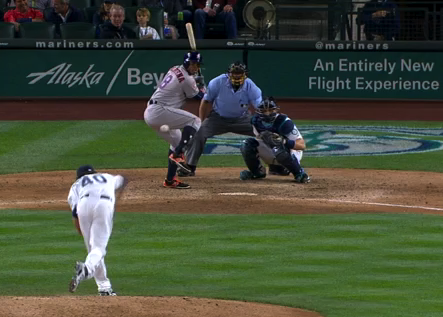While waiting around for sample sizes to become large enough to perform quality statistical analysis, let’s take a minute to perform some basic “eye test” inspections of a few players. Statistical analysis is only one part of evaluating players. To be thorough we should also look at other facets such as mechanics, strategy, and playing time.
Players are constantly working to improve aspects of their game. Some changes are small and go unnoticed, while others are in-your-face media sensations (e.g. Jon Lester throwing to first). Sometimes these alterations can be a challenge for players to maintain, especially if they had been doing something the same way for a long period of time. If a guy hits into the shift every at bat with no signs of altering his swing then he is most likely not going to be around very long. It is refreshing to see a player at least attempting to refine and adapt his skills, and that is what I will attempt to showcase in this series. I plan on continuing this string of posts throughout the season choosing a different player(s) each time. For this particular post we will look at Houston Astros infielder Luis Valbuena.
Valbuena was sent to Houston this off-season as part of a trade that sent Dexter Fowler to the Cubs. Originally I did not think much of this trade. I saw it as the Cubs making room for their log jam of prospects and the Astros reducing their plethora of center fielders while gaining a solid infielder who can play multiple positions. I think both teams have seen good signs early from their new acquisitions, but as I have been watching games this year I am starting to think that I may have undervalued Valbuena’s potential in Houston.
Going back to my original statement about player analysis this early in the season, although it may be too early to consider Valbuena’s counting and rate stats, we can still consider his overall approach. While watching a few Astros games I started to notice Valbuena showing some signs of opposite field power. I quickly pulled up his spray chart from last year and compared it to this years.


*The 2015 spray chart is missing Valbuena’s last two home runs
A majority of Valbuena’s home runs last year were to right field with a few sprinkled towards center field. This year he already has two dingers to left. This can mean one of two things. Either Valubena has modified his approach to take advantage of the short porch at Minute Maid Park, or he is doing nothing different and the shortened fence will simply catch some of the deep fly balls that would have normally been warning track shots at Wrigley. I tend to agree with the first line of reasoning and here’s why.
Players take batting practice everyday. During BP many players incorporate some sort of opposite field hitting drills. It would become evident fairly quickly just how easy it is to sneak one out down the line in left. If Valbuena figured this out it would make sense that he might change his approach – whether consciously or subconsciously. It’s not like he is a straight pull hitter. By looking at last year’s spray chart one can see that Valbuena pulled most of his groundballs, but scattered his fly balls around the yard. My point is that he has some power the other way. In most ballparks this is warning track power, but in Houston it’s home run power.
There is one more item to consider in my subjective analysis of Luis Valbuena, the Houston Astro. Take a look at Valbuena’s 2015 heatmap.

It’s pretty clear that pitchers last year tried to work him away most likely because they saw some success doing so. However, Valbuena will play a good number of his games in Houston this year and unless other teams update their scouting reports – which they eventually will – Valbuena could reap the benefit of his healthy dose of outside pitches. In fact, he is already doing just that.
Cue oppo bomb to the porch
Make a mental note to check back towards the All-Star break to see how Valbuena’s spray chart and heatmap has changed. My guess is Valbuena might get away with this for a half season, at most, before pitchers catch on and start to use other techniques – at least at Minute Maid Park – to suppress his opposite field power.
*Charts and graphs courtesy of Fangraphs.com
Next post: Worst to First: The Unbelievable Starts of Milwaukee and New YorkPrevious post: Chris Johnson, BABIP Darling: Can You Believe Again?





Leave a Reply